|
TRANSLATE THIS ARTICLE
Integral World: Exploring Theories of Everything
An independent forum for a critical discussion of the integral philosophy of Ken Wilber
 David Christopher Lane, Ph.D.
Professor of Philosophy, Mt. San Antonio College Lecturer in Religious Studies, California State University, Long Beach Author of Exposing Cults: When the Skeptical Mind Confronts the Mystical (New York and London: Garland Publishers, 1994) and The Radhasoami Tradition: A Critical History of Guru Succession (New York and London: Garland Publishers, 1992). David Christopher Lane, Ph.D.
Professor of Philosophy, Mt. San Antonio College Lecturer in Religious Studies, California State University, Long Beach Author of Exposing Cults: When the Skeptical Mind Confronts the Mystical (New York and London: Garland Publishers, 1994) and The Radhasoami Tradition: A Critical History of Guru Succession (New York and London: Garland Publishers, 1992).
DOUBTING MIND
Great Skeptical Thinkers
Susan Blackmore |
Brian Cox |
Martin Gardner |
Sam Harris |
Christopher Hitchens |
Harry Houdini |
Ray Hyman |
Phillip J. Klass |
Joe Nickell |
James Randi |
Adam Savage |
Eugenie Scott
Ray HymanAlexander Mendez“If you are going to have any chance at all to solve any problem, first make sure your facts are correct.” -- Ray Hyman Ray Hyman, born in Chelsea Massachusetts June 23, 1928, is a well-known pioneer of the modern skeptical movement which values evidence and logic in order to prove or disprove proposed claims. As a boy, Hyman grew interested in magic. By age seven, he began working as a magician, known as the Merry Mystic. Hyman immersed himself in the world of magic and mystery, learning about famous magicians such as Harry Houdini and his work with spiritualists. 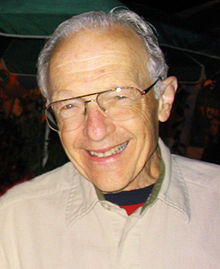 Ray Hyman Hyman practiced a kind of magic called mentalism, a form of performing art where the performer displays various intuitive abilities such as mind control, hypnosis, and telepathy. Hyman focused his skillset to palmistry, the practice of predicting one's future through the interpretation of the palm. Unlike other magicians, Hyman never disclosed that his practices were merely for entertainment, so many people believed that he could perform real magic. While an undergraduate at Boston University, a friend enticed Hyman to lie to his clients about what he perceived through their palms. Hyman tried this and was surprised to discover that his clients were still amazed by his readings supposed accuracy. Hyman wondered how this could be possible when he was giving inaccurate readings. He became obsessed with the reactions of his participants, which led him to change his major to psychology. Much of Hymans important research was not conducted until later in his educational career, particularly during his graduate career at John Hopkins University. At John Hopkins University, Hyman helped contribute to some groundbreaking research. One of his first and most famous publications was on the Hick-Hyman Law, created in collaboration with William Edmund Hick. The Law was initially named Hicks-Law; however, Hyman's name was added since it was his calculations that Hick revised. In the field of psychology, this research was considered the catalyst that caused the shift from the era of behavioral psychology to the age of cognitive psychology. The work was based on a theory that analyzed the relationship between options and reaction time. Hick and Hyman created a formula that conveyed reaction time relative to the number of choices, in addition to factors such as context and other available information. They found that reducing the number of stimuli that a participant must analyze reduced the amount of time it took for them to make a decision. These findings have been used for a wide range of applications, especially in product design. Product makers use the acronym KISS, “keep it short and simple,” to create user-friendly goods. The law impacted devices such as microwaves, washing machines, and even restaurant menus. Today, it is used in website and app development. After graduating from John Hopkins University with his Ph.D. in psychology, Hyman became an associate professor of psychology at Harvard University in 1953. In this same year, Hyman was chosen by The Department of Defense to investigate paranormal claims. His cases included a woman who claimed dermo-optical perception, or the ability to read blindfolded using only her fingertips, remote viewing, commonly referred to as astral projection, and the case of Uri Geller, which Hyman is best known for. His investigations into Geller began in 1972. Hyman was informed that Geller had the ability to bend metal with his mind; he was told that Geller once had taken a ring from a scientist, placed it on a table, and caused it to break and form an S-shape with his mind. Hyman discovered, however, that nobody really saw this happen. He was later told that Geller had brought the ring into the bathroom alone, then later brought out the bent metal. Hyman concluded that Geller was merely a fraud and had no paranormal abilities. In 1975, Hyman appeared on a television station in Portland, Oregon with magician Jerry Andrus. During the broadcast, they duplicated the tricks Geller had performed for Dick Klinger, the show's host, in the previous week. The replication proved that the tricks could be performed without the need of paranormal abilities. Soon after Hyman's discovery of Geller's bogus abilities, he met with other famous skeptics to form an organization called SIR, an acronym for Sanity in Research, in collaboration with Martin Gardner, and James Randi. Together in 1976, they merged with Paul Kurtz and others to form a new organization, called CSICOP, The Committee for the Scientific Investigation of Claims of the Paranormal, later renamed to CSI, or the Committee for Skeptical Inquiry. The group was established as a nonprofit organization that advanced scientific skepticism. It was heavily funded by their magazine, the Skeptical Inquirer. Based in Amherst, New York, Skeptical Inquirer's mission was rooted in Hyman's and his colleague's passion for critical analysis and pursuit of the truth. In addition to serving on the Executive Council for CSI, Hyman also published his own works in the magazine. His most famous work named “Guide to Cold Reading” was a thirteen-step instructional guide which taught readers how to practice psychic abilities, without actually being psychic. The secrets, claim Hyman, lie in factors such as the practitioners' confidence, observing body language, and fishing for information. According to Jim Alcock, another member of the Executive Council, this article was the most requested in the history of the Skeptical Inquirer. During his career at Harvard, Hyman published his work Water Witching USA (1959). The book focused on the practice of dowsing, a millennium-old technique used to locate water. Hyman provides historical background on dowsing and combats the controversial practice with surveys, experiments, and comparisons between traditional and professional techniques to find water. Hyman worked at Harvard until the year 1961. During that same year, he moved to the University of Oregon, earning another position as an associate professor. While at the University of Oregon, Hyman conducted the majority of the research and work he is best known for. In 1989, Hyman established the Skeptic's Toolbox, whose mission was to train people to become skeptics. The first meeting was held in Buffalo, New York. On all occasions since then, excluding a single event in Boulder, Colorado, the Toolbox meetings have been held at the University of Oregon. The Toolbox is set up as a four-day conference where people come from all round to practice their skills in skepticism. The conference is very hands-on and urges participants to split into groups to deliberate on lectures amongst one another. In the year 1982, Hyman spent a sabbatical at Stanford University. While there, Hyman held The Thomas Welton Stanford Chair for Psychical Research, also known as the Spook chair. During his time in the Spook chair, Hyman wanted to know what the best-known evidence for psi was. Psi is defined as extrasensory phenomena that cannot be explained by known biological processes. Hyman's probing led him to the Ganzfeld experiments. The Ganzfeld experiments were first conducted by German psychologist Wolfgang Metzger, meant to investigate the perception of a uniform visual field. His research was adopted by parapsychologist Charles Honorton, whom Hyman disagreed with. A Ganzfeld experiment contrasts with sensory deprivation since sensory stimulation is provided instead of eliminated. The experiment utilizes a receiver and a sender. The receiver is made to relax with bisected ping-pong balls placed over their eyes. They listen to static noise played through headphones, while a bright red light is shined at their face. At the same time, the sender observes a target they attempt to mentally convey to the receiver. The receiver tells the sender and experimenter what they can see, and the data is recorded. In order to judge the effectiveness of psi events, the receiver is given a set of possible targets after the experiment ends. The probability of the receiver choosing the correct target is 25%. Honorton argued that the success rate of about 35% was ample evidence to prove the existence of psi. Hyman objected, however, claiming that the results needed to be replicated further and the experiment had many flaws, particularly in its protocol, data-analyses, and documentation practices. Hyman produced two publications on the Ganzfeld experiments. His first was in the 1985 Journal of Parapsychology which included his extensive critiques. His second was published in collaboration with Honorton, named A Joint Communiqué. The publication focused on the problems the experiments had, which both Honorton and Hyman agreed with. They concurred that replications needed to occur in order to verify Honorton's claims and that more rigorous protocols were needed to rectify the resulting data. For Hyman's extensive contribution to the areas of psychology, parapsychology, and skepticism, he's earned many awards and recognitions. Hyman has received two awards from CSICOP, the first being the In Praise of Reason Award, given to people recognized for their influential use of reason and logic to appraise claims of intelligence. It was presented to him by his close companion James Alock in 2003. The second award, the Robert P. Balles Prize in Critical Thinking, was given to Hyman for his published work “Testing Natasha” from Skeptical Inquirer. He earned the reward for employing excellent logical analysis to a complicated problem. Hyman has also received other awards from various institutions. In 2007, Hyman received a Doctor of Science, Honoris Causa from Simon Fraser University. The Honoris Causa award is given to persons who have made remarkable contributions to their fields of work and study. Hyman also received the Philip J. Klass Award by National Capital Area Skeptics (NCAS) in 2010 for his promotion of scientific inquiry and analysis. Finally, in 2011, Hyman received one of his most notable awards of all, the Houdini Hall of Honor award. This was presented to him via the Independent Investigation Group for his “commitment to educating the public in skeptical thinking through entertainment.” After a long and adventurous career, Hyman decided to retire in 1998. He hasn't, however, stopped advocating for scientific inquiry and skepticism. Hyman still gives lectures on skeptical issues and methods. He is in the process of publishing two new books: Parapsychology's Achilles' Heel: Consistent Inconsistency and How Smart People Go Wrong: Cognition and Human Error. Although retired, CSI has encouraged Hyman to remain as an Executive Council member, a position he still currently holds. Hyman will forever be remembered as a trailblazer in the fields of psychology, parapsychology, and most importantly, the skeptical movement. Further Reading1. The Elusive Quarry: A Scientific Appraisal of Psychical Research, Prometheus Books. 2. The Nature of Psychological Inquiry, Prentice Hall (June 1, 1964) 3. Andrus Card Control, J A Enterprises (1976) 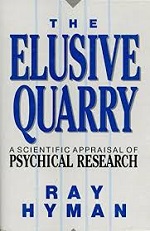 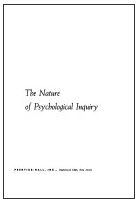 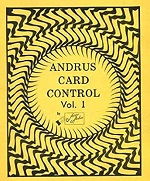
PREFACE | David Christopher Lane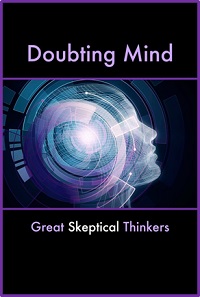
Before the current pandemic altered our day to day lives, the MSAC Philosophy Group had been working on a book entitled, Doubting Mind: Great Skeptical Thinkers, which contained separate essays on a number of notable researchers who champion critical thinking and skepticism when analyzing paranormal claims, such as UFOs, astrology, and various religious claims. The book has now been finished, though it took a bit longer than we anticipated. The word skeptical has too often been conflated with the word cynical. The former term comes from the Greek word skepsis which properly defined means "to look, view, observe." Or, as Miguel de Unamuno explained in 1924 in his book, Essays and Soliloquies, "Skeptic does not mean him who doubts, but him who investigates or researches as opposed to him who asserts and thinks that he has found." To be cynical, on the other hand, indicates that the person is "[pre] disposed to disbelieve or doubt the sincerity or value of social usages or personal character or motives and to express it by sarcasm and sneers, disparaging of the motives of others, captious, peevish." Therefore, it is important to understand that a skeptic is not one who ad hoc dismisses borderland ideas, but is one who is willing to go the extra mile to gather more (not less) information about any given phenomenon. As I have often remarked (to the obvious consternation of certain cult followers), we, humans, are too gullible when we accept miraculous claims without further investigation. We are cheap sluts for the paranormal, believing too easily in conspiracy theories that defy the known law of physics. There are many reasons why this is so, but I suspect that in a world where everything eventually eats one another to survive (whether it be a vegan eating plants or a carnivore eating meat), any organism that can develop a buffering illusion to survive such a horror show has an evolutionary advantage over others that cannot. This came into sharper relief for me this past week as I watching the British made television mini-series, War of the Worlds, where in one particularly poignant scene a mother who has just witnessed the death of her children at the hands of an alien species realizes that there is no point in continuing to live in such a horrific environment. She opts to shoot herself and the viewer instead of being shocked perfectly sympathizes with her decision. Nature is a madhouse if looked at objectively and therefore it is not surprising that we have evolved all sorts of mental defense systems in order to live long enough on terra firma to pass on our genetic heritage. Since we are the survivors in this boiling cauldron of eat or be eaten, we have inherited a variety of tools to ward off the true existential dread that can overcome any being that becomes too keenly aware of how this DNA game plays out. I mention all this as a necessary preface, since no matter how well versed we may become in science (and trained to become good doubters, in the positive sense of that term), we still retain at the core of our beings a deeply emotional component that defies a purely rational or logical way of being. We may act like scientists from time to time, but we are not scientists in the long term. We are vulnerable creatures and our myths and our fairy tales will persist even if we opt for agnosticism or atheism, though they may take on a different color and hue and justifications. Thus, this book provides us with but a small glimpse of how to think more rationally and critically, despite the sobering realization that we cannot be great skeptics all the time.
Comment Form is loading comments...
|